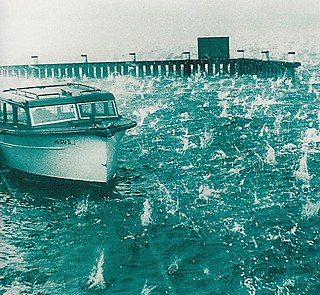 W
WThe 1947 Sydney hailstorm was a natural disaster which struck Sydney, Australia, on 1 January 1947. The storm cell developed on the morning of New Year's Day, a public holiday in Australia, over the Blue Mountains, hitting the city and dissipating east of Bondi in the mid-afternoon. At the time, it was the most severe storm to strike the city since recorded observations began in 1792.
 W
WThe 1999 Sydney hailstorm was the costliest natural disaster in Australian insurance history, causing extensive damage along the east coast of New South Wales. The storm developed south of Sydney on the afternoon of Wednesday, 14 April 1999 and struck the city's eastern suburbs, including the central business district, later that evening.
 W
WThe 2003 Melbourne thunderstorm was a severe weather event that occurred over the city of Melbourne, Australia, and surrounding areas of Victoria, from 1 to 6 December 2003. The Australian Bureau of Meteorology called the storm a "once in 100-year event".
 W
WThe June 2007 Hunter Region and Central Coast storms started on Friday, June 8th following the development of an intense east coast low pressure system during the previous night. Over the next 36 hours these areas were battered by the system's strong winds and torrential rain, which caused extensive flooding, damage, loss of life and the grounding of a 225 m (738 ft) long bulk carrier. The strongest observed wind gusts were 135 kilometres per hour (84 mph) at Norah Head and 124 kilometres per hour (77 mph) at Newcastle.
 W
WThe 2008 Queensland storms were a series of three thunderstorms that struck South East Queensland. The first storm hit on 16 November 2008 and was followed by two further storms on 19 and 20 November. The storms resulted in 2 fatalities.
 W
WThe 2010 Western Australian storms were a series of storms that travelled over southwestern Western Australia on 21 and 22 March 2010. One of the more intense storm cells passed directly over the capital city of Perth between 3:30pm and 5:00pm on Monday 22 March 2010. It is the costliest natural disaster in Western Australian history, with the damage bill estimated at A$1.08 billion.
 W
WThe 2014 Brisbane hailstorm struck Brisbane, the capital city of Queensland, Australia on 27 November 2014. The storm caused severe damage to many buildings and cars in the city. Around 40 people were injured. Wind speeds of 141 km/h (88 mph) were recorded with multiple reports of hail in the city and surrounding areas.
 W
WAustralian east coast lows are extratropical cyclones. The most intense of these systems have many of the characteristics of subtropical cyclones. They develop between 25˚ south and 40˚ south and within 5˚ of the Australian coastline, typically during the winter months, but may occur in autumn and spring as well. Each year there are about ten "significant impact" maritime lows.
 W
WDrought in Australia is defined by the Australian Bureau of Meteorology as rainfall over a three-month period being in the lowest decile of what has been recorded for that region in the past. This definition takes into account that drought is a relative term and rainfall deficiencies need to be compared to typical rainfall patterns including seasonal variations. Specifically, drought in Australia is defined in relation to a rainfall deficiency of pastoral leases and is determined by decile analysis applied to a certain area. Note that this definition uses rainfall only because long-term records are widely available across most of Australia. However, it does not take into account other variables that might be important for establishing surface water balance, such as evaporation and condensation.
 W
WSevere storms in Australia refers to the storms, including cyclones, which have caused severe damage in Australia.